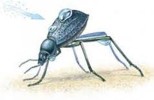DEW01/03/2016 – 31/08/2017
Detachment of water (DEW):
Light-modulated wettability and droplet adhesion on photoresponsive honeycomb-structured porous films
This project received funding from the European Union’s Horizon 2020 research and innovation programme under grant agreement No. 661823 (DEW) from 01/03/2016 – 31/08/2017.
Overview
The project was conducted at the EPCP group (IPREM, UPPA, Pau, France) supervised by Prof. Laurent Billon and supported by the ECP team led by Dr. Sylvie Lacombe, Prof. Ross Brown, and Dr. Sylvie Blanc. In addition to exploring light-responsive honeycomb films, light-responsive biomaterials were developed in a 3 month secondment at the Dynamic Biomaterials group at the Institute for New Materials (INM, Saarbruecken, Germany) led by Prof. Arancha del Campo.
Light-responsive honeycomb films
Honeycomb-structured porous films are phenomenal materials formed in the same way that your breath condenses on a cold window.[1] When azobenzenes are components of the films, their polarity can be reversibly switched between two states by using particular wavelengths of light.[2] This affects how water droplets interact with the surface, and allows light-triggered control of wetting rather than using other stimuli such as pH value.[3] Figure 1a shows the UV/Vis absorption spectra of an azobenzene polymer after irradiation to switch the azobenzenes from their intial trans state, to their more polar cis state, then back to a trans-rich state. Photos of the solution also show a beautiful colour change, from yellow (trans) to red (cis), courtesy of the different absorption characteristics of the two isomers. Honeycomb films made from an azobenzene-based polymer show highly regular porous structure, and can even be cast on water (Figure 1b) or converted to the distinctive “pincushion” topography by peeling off the top layer of the film (Figure 1c). This work was presented at the recent European Polymer Congress in Lyon, France.[4]
Light-responsive biomaterials
The Dynamic Biomaterials group at the INM (Saarbruecken, Germany) develops biomaterials which emulate natural systems and whose functions can be controlled by light. The photoresponse is typically irreversible, triggered by the “uncaging” of bioactive peptides or proteins.
Two projects were pursued within the Dynamic Biomaterials group. The first developed an azobenzene-based peptide containing an amino acid sequence critical to critical to controlling cell-cell adhesion. Reversible presentation of the active ligand courtesy of the azobenzene function is hoped to provide additional functionality not accessible using caged species. The second developed glycopolymers which can strongly bind living cells to form active hydrogels.
[1] G. Widawski, M. Rawiso and B. Francois, Nature, 1994, 369, 387-389.
[2] S. Pearson, D. Vitucci, Y. Y. Khine, A. Dag, H. Lu, M. Save, L. Billon and M. H. Stenzel, European Polymer Journal, 2015, 69, 616-627.
[3] P. Escale, W. Van Camp, F. Du Prez, L. Rubatat, L. Billon, and M. Save, Polymer Chemistry 2013, 4 (17), 4710-4717.
[4] S. Pearson, P. Marcasuzaa, S. Lacombe, L. Billon; Detachment of water (DEW): Light-modulated wettability and droplet adhesion on photoresponsive honeycomb-structured porous films, Oral Presentation, Congress of the European Polymer Federation (EPF), 2 – 7 July, Lyon, France
Biography
After completing his PhD in 2014 supervised by Martina Stenzel at CAMD (UNSW, Australia) working on novel glycopolymers for drug delivery, Dr. Samuel Pearson joined the Chemistry, Catalysis, Polymers and Processes (C2P2) group at the CPE (Lyon, France) as a postdoctoral fellow developing nanocomposite latexes by RAFT emulsion polymerisation and telechelic polyolefins by catalytic chain transfer polymerization. He then conducted the 18 month Marie Skłodowska-Curie Individual Fellowship outlined above. Having just finished the DEW project, the dissemination of results is his main focus. Watch this space for upcoming publications and other related news arising from the project.








_55x281.png)






